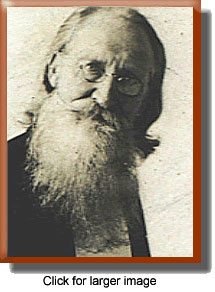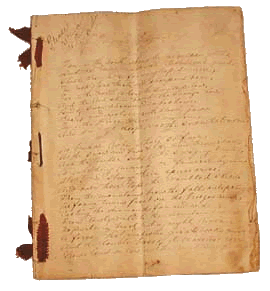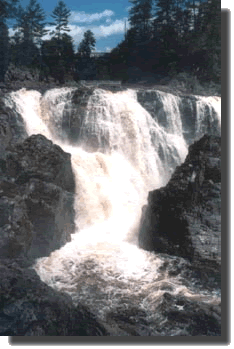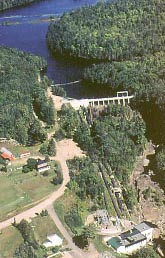|
John Harwood Pierce
Biography: Part 1 1848 to 1860
 Born in Quebec. John Harwood Pierce was born February 29, 1848 in
Waltham, Province of Quebec, Canada. He
died in 1925 at the age of 76 in Los Angeles, California. His life
mirrors the remarkable changes that took place in American society
during this fascinating period in history.
Born in Quebec. John Harwood Pierce was born February 29, 1848 in
Waltham, Province of Quebec, Canada. He
died in 1925 at the age of 76 in Los Angeles, California. His life
mirrors the remarkable changes that took place in American society
during this fascinating period in history.
Electric lights, transcontinental railroad systems, telephones,
automobiles, airplains, motion-pictures--all these occurred during his
lifetime. He played an active role in the taming of the Wild West and
the emergence of an industrial society.
John Harwood Pierce's America was a country in a constant state of
upheaval, evolution, and change. His life mirrors that vitality and
recklessness. During his long life, John Harwood Pierce led many
separate lives:
- the isolated life of a pioneer on the rugged Canadian frontier;
- the hand-to-mouth existence of a migratory farm laborer across
the prairies of Illinois;
- a Civil War soldier;
- a teacher of freed slaves in the southern states;
- a ranch hand on the wild western frontiers of Nebraska and South
Dakota;
- an Indian scout fighting against the Sioux Indians in the Black
Hills;
- a journalist participating in, and writing about, some of the
momentous historical and cultural events of this period;
- a literary publisher;
- an inventor;
- a minister;
- and from time-to-time, particularly during his autumn years,
when other avenues of earning a living were closing to him, he made
money as a lecturer and showman.
But the one unchanging role he maintained throughout his life was that
of a poet. In his own words, toward the end of his autobiographical
poem, A Ranger's
Biography,John described his charmed and mutifaceted life as...
- ...like my rhyme,
- Rude, broken, changing, wild.
Heritage. John Harwood Pierce was born to prime Colonial New
England stock and educated at home by parents who traced their heritage
back to Captain Michael Pierce (b. 1615). This first-generation American
immigrated in the early 1640s from Higham, Kent, England to Scituate, in
what later became Massachusetts. Captain Michael Pierce was the brother
of the famous Colonial sea captain, William Pierce, who helped settle
Plymouth Colony. Today, in Scituate, there is a Captain Michael Pierce
Monument and a Captain Pierce Road.
Lineage. According to Fredrick Clifton Pierce, author of
Pierce Genealogy Being the Record of the Posterity of Capt. Michael,
John and Capt. William Pierce (Albany, NY: Joel Munsell's Sons,
1889), as well as John's own brief genealogy (see references below),
John Harwood Pierce descends from Captain Michael Pierce as follows:
NOTE: The eight detailed genealogies
linked below, as well as the current biography of John Harwood Pierce,
are in a constant state of research and change. Corrections and
new additions are being made to these documents on a frequent basis as
new information is uncovered, or former information is proved false.
Most of the information in the genealogies is based on research
originally done by Fredrick Clifton Pierce and published in his Pierce
Genealogy, cited above. The author of these current documents, Barbara
Sharon Case (John Harwood Pierce's granddaughter), is attempting to
update that reserach, and add to it with further research on her own.
The biography of John Harwood Pierce is derived from a detailed study and
analysis of primary source records from his own personal archives; it is
also supplemented by extensive library research. This genealogical and biographical
research process is ongoing and will most likely extend well into the first decade
of the 21st century. Until that research process is completed, all
these documents should be considered DRAFTS. You can contact the author,
Barbara Case, at:
scrubjay@adelphia.net
- Captain Michael Pierce, b.
1615 (m. Persis Eames)
- Captain Benjamin Pierce,
b. 1646 (m. Martha Adams)
- Benjamin Pierce, b. 1683
(m. Mary Cowan)
- Benjamin Pierce, b. 1721
(m. Charity Howard)
- Deacon Benjamin Pierce, b.
1746 (m. Priscilla Merritt Wade)
- Benjamin Pierce, b. 1777
(m. Deborah James)
- John James Pierce, b. 1801
(m. Fanny Harwood)
- John James Pierce, Jr., b.
182- (m. Mary Almira)
- John Harwood Pierce, b. 1848
When John was in his seventies and living in Los Angeles, he wrote a
brief genealogy of his family line as background material for a local
newspaper (either the "Santa Monica Outlook" or the
"Santa Monica Evening Outlook") which ran a story about John
and his colorful family history.
The first six generations of this genealogy merely paraphrase
information found in the Fredrick Clifton Pierce genealogy. But the
document gives completely new information about the 7th and 8th
generations, John's grandparents and parents, and therefore the verbatim
text of these two generations is attached
to this biography. It provides a treasure of names leading to
further genealogical research. It also raises several confusing
contradictions. In this document, John tells about his grandparents and
parents, and gives detailed information on living and recently deceased
relatives.
 Autobiographical Poem.
In 1890, when
John was 42 years old, and living in New York, he wrote an autobiography
in the form of an epic poem. From the tone of the poem, and its
dedication, it appears that John may have been suffering from a major
clinical depression at the time. In the months before the poem was
written, John lost his entire life's savings in a Wall Street investment
prospectus. Autobiographical Poem.
In 1890, when
John was 42 years old, and living in New York, he wrote an autobiography
in the form of an epic poem. From the tone of the poem, and its
dedication, it appears that John may have been suffering from a major
clinical depression at the time. In the months before the poem was
written, John lost his entire life's savings in a Wall Street investment
prospectus.
The poem is a handwritten manuscript entitled, A Ranger's
Biography. The poem is long, being a full 269 lines in length, and
it is written on 12 sheets of heavy paper. The sheets are roughly sewn
together with red ribbon and fine brown silk twine, forming a booklet.
Diagonally, across the top left corner in the author's handwriting are
the words: "Please return to the author." The full
transcription of the text of this poem is linked to this biography. Click on the
image of the manuscript here to see a larger, readable image of the manuscript.
The original manuscript was constructed in such a rugged fashion that it
seems highly likely it was used as a stage prop to impress audiences
during lecture engagements.
Parents and Early Childhood. John's father, John James Pierce, was born in Hillsboro, New Hampshire but later moved to
Waltham, Pontiac County, Province of
Quebec, Canada with his wife Mary Almira. John's father was a Methodist
missionary. In moving to Waltham, it was his plan to convert the Ottawa
Indians and to preach the Word of God among a sparse population of
pioneer fur trappers and loggers.
John's parents had three children: Clarissa Matilda, John Harwood, and
Louis. Louis drowned at an early age in the Black River, which ran near
their house. John writes about this early time in these words:
Every river, pool and lake in that region has yielded its fish in
abundance to my lure. Every den and swale, every cliff and crag, were
known to me; and the bear, the deer, the mink, the beaver, the fox, the
wolf, and the panther or mountain lion, were the victims we gloried in
deluding to their death. It was war, and we would have gone down in the
fray if they had had the better skill. Often, we were near to death with
the powers of the wilds proving stronger than we, but God's goodness
remembers the sparrows. Black River on which the "Pierce
Place" is situated, is a deep, dark, swift, dangerous stream. It
buried my brother Louis.
On Sunday, August 26, 1917, the Oakland Tribune, a northern Californian
newspaper, published a feature interview with John Harwood Pierce. At
the time, he was 69 years old. In that interview, he is quoted as
saying this about his childhood home in Waltham:
 I was born
within the spray of the Black River Falls --the greatest falls so far as
I know --in all of Canada. When the wind was fair, the spray would blow
in our yard. It was very interesting there when the ice would form in
six-foot blocks and come tumbling down 200 feet. You can imagine the
roar. I was used to thunderous sounds long before I ever went to war.
When the ice would pack so that it would break all the chains of the
boom above the logs and frozen blocks would crash down with a tremendous
detonation. It was a wild sight. I was born
within the spray of the Black River Falls --the greatest falls so far as
I know --in all of Canada. When the wind was fair, the spray would blow
in our yard. It was very interesting there when the ice would form in
six-foot blocks and come tumbling down 200 feet. You can imagine the
roar. I was used to thunderous sounds long before I ever went to war.
When the ice would pack so that it would break all the chains of the
boom above the logs and frozen blocks would crash down with a tremendous
detonation. It was a wild sight.
When I was a boy, my friends were Indian children. My sports were
catching fish with them and spearing our spoil, trapping, hunting. Why,
I thought nothing of going out and getting a whole string of fish.
Hunting was one of our principal joys. Otter--why, their furs are worth
a king's ransom today. Mink--all those animals were common when I was a
boy. Bears--we used to kill bears, too. Big fellows. Then we had other
delights. There were hundreds of maple trees that we would sap in the
spring and get hundreds of pounds of maple sugar. Think of that, if you
have a sweet tooth! It was a frontier jamboree when they sugared off.
 You know,
you can't wear shoes in winter in that country. Oh no! Too
cold. You wear buckskin. Now if the weather was very severe, we would
wet the moccasins with water. That would close the pores and hold the
heat in. Funny that ice will keep in heat--but it
does. You know,
you can't wear shoes in winter in that country. Oh no! Too
cold. You wear buckskin. Now if the weather was very severe, we would
wet the moccasins with water. That would close the pores and hold the
heat in. Funny that ice will keep in heat--but it
does.
The photograph above does not show the Waltham waterfall on the Black
River. Unfortunately, that mighty waterfall is gone forever; the
hydroelectric power station and dam you see here at the left stands there now.
The waterfall above is of the Coulonge Chute, which pours into the Ottawa
River a few miles further
downstream. The Coulonge has a geology and environment very similar to
what the Black River must have looked like prior to the building of the
dam. Historical records show the Black River waterfall to have been some
25 feet shorter; also, it did not have a narrow "chute" at the
end. Today, the Coulonge Chutes are considered to be one of Canada's
national treasures.
In his autobiographical poem, A
Ranger's Biography, John writes about his early home on the
Black River in Waltham, in almost mythic proportions.
- Far in the North where the glaciers glide,
- And the bark canoe with its skillful guide,
- Shoots through the foaming rapids where,
- The rocks are thick and sharp and bare.
- Far in the North where the sun dips low,
- And the red skin bends the savage bow,
- Land of snowshoes and cabashaws,
- Bears and wolves with bloody jaws,
- This is the place where I was born
- And six foot deep was the snow that morn.
- No bridal robe is half so fair,
- As the snow and frost the pine trees wear,
- And the tender songs of the swaying limbs,
- Is wedding march or funeral hymn.
- Stately and strong their spires arise,
- And over their tops the vaulted skies.
- From the mountains' brow the falls out spring
- The foam turns frost on the breezes wing,
- Casting the diamonds far and wide,
- From the lowly vale to the mountain side,
- No purling brook but a mighty river,
- A force that makes the great rocks quiver
- And the double base of the ceaseless roar
- Grows loud or low as the wind sweeps o'er.
- The grottos and caves, the sculptured halls,
- Beneath and back of the grand old falls,
- Nature's work shop, wonders home,
- Every niche from floor to dome,
- Is filled with the gems and curious arts,
- That are worked without hands, or eyes or hearts.
- An old brown house, and numerous fields,
- The orchard garden and thicket yields
- Fruits and flowers and singing birds,
- While mother's and sister's loving words
- Awakes the music of heart and soul,
- Sweeter than all the notes that roll
- From organ's tones though rich and grand,
- When the keys are touched with the master's hand
- And mother's mother I see her face,
- Bright with love and sweet with grace.
- The brow was seamed and the eyes were dim,
- But God loved her and she loved Him.
Leaves Home at 11 and Moves to the United States. When John was
11 years old, he moved to the United States. [This fact is verified on
a 1920 census document on which John indicates that he emigrated to the
U.S. from Canada in 1859. This same document shows that John became a
naturalized U.S. citizen in 1878.]
In his autobiographical poem, A
Ranger's Biography, John writes about his leaving home at the
age of 11, with these haunting lines.
- Wild were the boys in that backwoods home,
- And the girls were wild as the deer that roam
- Nature was strong in their bounding veins,
- Colts that never were broke to reins
- And so it came that one fine day.
- I picked up my bundle and walked away,
- I was less than twelve when I left my home,
- And never since then have I ceased to roam.
Youth Wandering Alone.
In the three years that followed, John appears to have wandered around
Illinois, earning a meager living harvesting crops. He writes about
having to lie about his age, and fearing that he might die if anyone
found out how young he really was at the time.
- The grand prairie of Illinois
- I trod alone,
- A careless, busy, laughing boy.
- Yet oft a groan
- Would come unbidden to my lips
- For poor, so poor
- Was I, that all the finger tips,
- Worn out with toil
- Would tinge the yellow ears of corn,
- With my warm blood.
- Or when the harvest sheaves were bound,
- In stations long,
- I tottered o'er the hot and dusty ground,
- Thinking a wrong,
- If once the old reaper juggernaut
- Should come with roar
- To find me gasping "Yes, I'm caught."
- A man no more,
- Only a little boy, the thought,
- Still nerved my arm,
- And though I lacked the years, I wrought
- Full hand upon the farm.
In 1915, when John was 66, his newphew Walter Smith (Clarissa Matilda
Pierce Smith's son, then living as a Methodist minister in Monroe,
Michigan) wrote a letter to his uncle. In this letter, he speaks very
carefully about John's early days, as if there were some family secret
which could not be revealed. Walter's letter reads in part:
My Dear Uncle John;
I thank you for your letter...
I wish you would tell me of the friends of your boyhood. Please give me
the addresses of that Member of the Canadian Parliament and his name,
also that of the Nephews and their addresses [by nephews, Walter must
refer to the children of John's Uncle Harwood, and Aunt Julia C. Pierce
Bulmer, who also settled in Canada, near Waltham]. If I ever happen up
that way in my travels, I would love to have a chat with them. I am
more mature and discreet than you may imagine Uncle, and I would not get
my neck, or anybody elses, in a noose if I were to visit around those
old coots and haunts... I would try to keep out of trouble... You must
realize how dear all of that old ground would be to me since it was the
scene of my mother's early girlhood.... I would dearly love to talk over
all of those things with her and have her tell me of those early
girlhood days up in the northern Canadian hills. Of the struggles, the
hopes and fears, the vicissitudes of those early days... You must be
more or less familiar with the places up in Renfrew [County]that were
once the haunts of my mother's early days. Every inch of it would be
sacred ground to me if you could give me names and locations... I crave
this information just for my own use and satisfaction. Thanking you for
your letter, and with love to you and yours, I am
Affectionately your Nephew
Walter
Both the poem and the letter from Walter seem to indicate that there was
some secret reason surrounding John's leaving home when he was only 11
years old. What could this secret be? Unfortunately, it is a mystery
which appears to have no solution, or hint where a solution might be
found. Perhaps a safe conjecture is that John's natural wild spirit
could not abide the strict discipline of his minister father.
John's Parents Moved to Ionia, Nebraska. John writes in his family
genealogy that first, his father and uncle Harwood went to United States
having "been called [by the Church and God] to undertake a mission
to preach abolition of slavery in the Southern States." But, they
met "with revelry and severe violence at the hands of the
Southern mobs and returned north." At Davenport, Iowa, John's
father met Judge Loren T. Hill and, at his suggestion, undertook a
journey to Nebraska to buy land. He purchased the old town site of Ionia
for Judge Hill and sent word for his wife and daughter in Canada
"to join him in the west."
John's mother and sister undertook the long and dangerous journey to
Ionia, Nebraska from the Pierce place on the banks of the Black River in
Waltham, Province of Quebec, Canada.
John writes about himself, his mother and sister, as follows:
John H[arwood Pierce], his son, was already in the States. His wife
[Mary Almira] and daughter, Clarissa Matilda [Pierce] undertook the long
and dangerous journey.They travelled the first lap of the trip by water,
and were shipwrecked, barely escaping in their night clothes in an open
boat. The journey accross Illinois and Iowa was accomplished in rude ox
carts, devoid of springs, and with high wooden wheels hewed out of solid
timbers. The country was new and the roads were rough. Very often,
stretches of corduroy road would extend for miles. [John's sister]
Clarissa Matilda walked the entire distance accross the State of Iowa,
preferring to walk rather than ride in the ox carts. The caravan would
make, on average, about ten miles a day. But the journey was made, and a
home was built on the banks of the Missouri River about three or four
miles above the old town site of Ionia.
This farm has long since been swept into the treacherous river. John
James Pierce [John's father] is buried on the hill overlooking the town
of Vermillion, S.D.
Click Part 2
here, or below, to continue this biography.
|